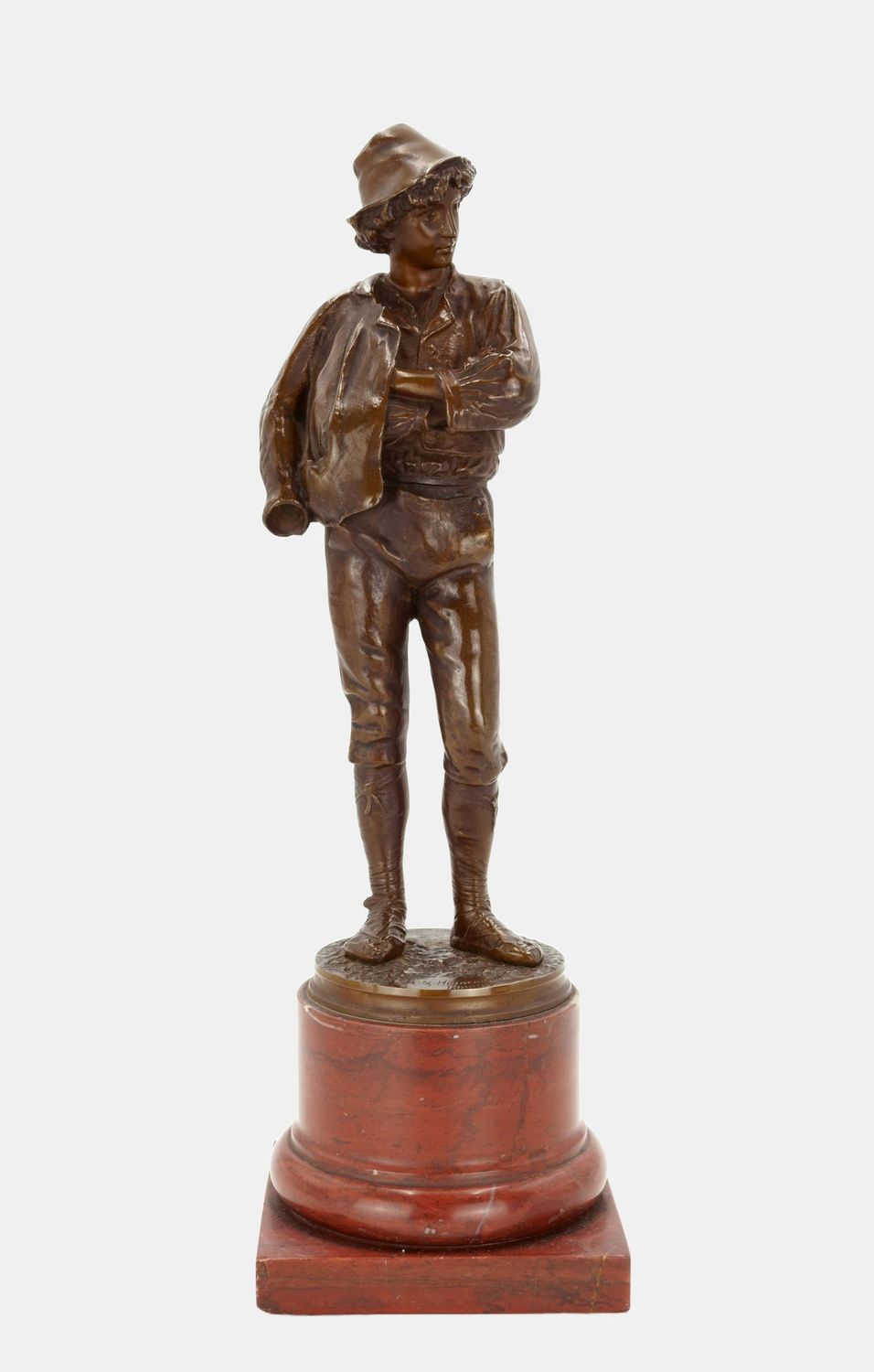Heinemann, Fritz (1864-1932), Young Roman, 1892
Fritz Heinemann(1864 Altena - 1932 Berlin), Young Roman , 1892. Brownish patinated bronze on a cast round plinth, mounted on a red marble base (8.5 cm high), total height 36 cm, dimensions of the bronze 27.5 cm (height) x 9 cm (length) x 8 cm (width), weight 3.3 kg. Signed on the plinth “Fritz Heinemann”, inscribed with “Roma.” and the foundry's mark “Akt. Ges. vorm. H. Gladenbeck & Sohn”.
- Bronze in impeccable condition, marble base with two corners dented and scattered scratches.
- Youthful Sprezzatura -
Until the end of the 19th century, Rome was the Mecca of German artists, although it was to be visibly replaced by Paris. Especially with the Nazarenes, including Peter von Cornelius, Friedrich Wilhelm Schadow, Friedrich Overbeck, Julius Schnorr von Carolsfeld, and Joseph Anton Koch, the pilgrimage to Rome became obligatory for aspiring German artists from the 1820s on. Soon there was even talk of "German-Romans," who also took up institutional residence in Rome. The German Artists' Association, which existed until 1915, was founded in 1845, and the German Academy, which still exists today, was inaugurated in the Villa Massimo in 1913
After Fritz Heinemann had spent time in Paris in 1891, he was also drawn to Rome the following year. There he created the statuette of a young Roman. The 19th century also saw the increasing artistic discovery of the "people". Instead of a David, in whose artistic tradition the sitter stands, we see a young man as the artist might have met him on the street. Nor is he performing a heroic deed, or at least alluding to such an act, as is the case with David. Yet he appears strong-willed and determined, even though his jacket is casually slung over his shoulder and he stands in an almost casual contrapposto. Instead, his arms are crossed and his sideways gaze is determined. Despite his generally relaxed posture, the youthful fire is palpable, even if he himself is not yet able to foresee where it will take him in life.
If the face is idealized to depict the quintessential young Italian man, the multilayered clothing is all the more realistic. Every detail is masterfully and meticulously worked out. The jacket is a true virtuoso piece. It is precisely this skill that creates the natural impression of being thrown on. Italian art theory coined the term sprezzatura for this, which Heinemann clearly wanted to demonstrate here and which makes the artist appear like the young man depicted.
About the artist
After attending the Arts and Crafts School in Nuremberg (1883-85), Fritz Heinemann began studying at the Berlin Academy of Art, where he was taught by Albert Wolff, Fritz Schaper, and Gerhard Janensch until 1889. The purchase of his work "Mother and Child" by Prince Albrecht of Prussia for Schloss Camenz, which was shown at the International Art Exhibition in Berlin in 1892, was the prelude to future state commissions and also made Heinemann a sought-after artist in bourgeois circles.
He undertook study trips to Paris (1891) and Rome (1892). In 1897 Heinemann was awarded the Gold Medal in Berlin for his group "Homecoming from the Field". In 1899 he was appointed professor of sculpture at the Königliches Kunstgewebemuseum, where he taught until 1905. In 1906 he went on another study trip to Paris. Back in Berlin, he had productive years, exhibiting his work at the Great Berlin Art Exhibitions, the Munich Glass Palace, and the Great Art Exhibitions in Düsseldorf and Dresden. Emperor Wilhelm II was one of his clients.

